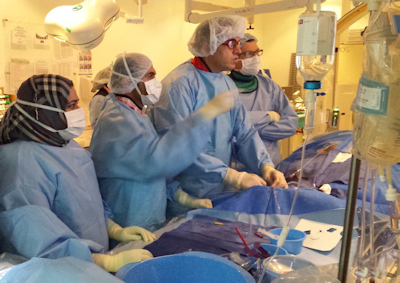
Uterine angioplasty (UAE) is one of the distinguished developments in women's health in the current century, as it has become a reliable, safe and effective alternative to the traditional surgical treatment of uterine fibroids, which are the most common benign gynecological tumors.
The catheterization of the uterine arteries (UAE) was launched in the United Arab Emirates several years ago, as part of the major developments in the development of health care services in general and the development of interventional and gynecological radiology in particular.
uterine angioplasty angioplasty the operation
Uterine angioplasty has aroused great international interest since it was first used to treat symptoms of uterine fibroids in France in 1995. The principle of catheterization of the uterine arteries is to stop the supply of uterine fibroids with blood and food, which leads to its gradual atrophy and shrinkage. This is achieved by injecting microscopic particles into the uterine arteries through a catheter without surgical intervention.
International studies have confirmed that catheterization of uterine fibroids is a safe and effective treatment with a total technical success of 95%. These studies also showed impressive success in controlling and eliminating symptoms associated with uterine fibroids, such as heavy menstruation and menstrual pain, compared to the process of removing uterine fibroids and hysterectomy. Moreover, the recovery period after uterine angioplasty is shorter and blood loss is less compared to hysterectomy and fibroid removal so that the woman returns to her life after the catheterization within five days.
Patients who are candidates for uterine angioplasty
Most women with symptoms of uterine fibroids are candidates for uterine angioplasty unless contraindications exist. However, medical examination and evaluation of all patients by gynecologists and interventional radiologists is the cornerstone of proper medical practice.
The absolute contraindications are the possibility of pregnancy, and the presence of confirmed or suspected gynecological malignancies. Relative contraindications include blood-thinning diseases, allergy to the contrast media used for catheters, renal failure, and endometriosis and pelvis.
Uterine angioplasty in the United Arab Emirates
Din Al-Qutaish, Director of Radiology and Head of Interventional Radiology at Tawam Hospital and Al Ain Hospital. He was able to establish the most modern and most famous catheter fibroid clinic in the Middle East at Al Ain Hospital within three years.
We treat more than 100 cases annually, and receive referrals from countries in the Gulf Cooperation Council and the Middle East. Moreover, many patients refer themselves to the Fibroid Clinic at Al Ain Hospital through the internet or their doctors.
Measures have also been taken to make the operation available in most major hospitals in Abu Dhabi. This has led to significant progress in the quality of health services provided to female patients in the UAE by the Abu Dhabi Health Services Hospitals (SEHA).
The treatment method for all cases is discussed in the multidisciplinary medical team meetings within the gynecology department before the catheterization is performed. Several gynecologists in the UAE have started offering uterine angioplasty as a treatment option for fibroid patients during their consultation and when discussing additional treatment options.
Preparing the patients
Patients with symptoms of uterine fibroids are referred to the interventional radiology clinic for further evaluation and treatment plans. Patient data, clinical history, physical examination, imaging results and laboratory tests are reviewed and the process explained to all patients and consent is obtained from them. All patients are also informed about the advantages of this operation, its success rate, risks of failure, complications and available alternatives.
Fertility issue and pregnancy after catheterization
The process of catheter fiber treatment preserves the uterus and fertility, and this aspect is very important in the United Arab Emirates due to the characteristics of patients with uterine fibroids, as many women are young and unmarried and want to preserve their fertility, which makes the option of hysterectomy rejected in most cases.
Positive results have been reported regarding successful pregnancy following catheterization. We have pregnant patients after catheterization and we have patients who delivered after catheterization without any problems.
Pain management and complications
The entire catheterization process is performed on all patients on the same day, and they are discharged from the hospital in the evening of the same day and the pain is treated by using the strongest analgesics and anti-inflammatories to control the pain after the catheterization. Patients are also closely monitored after the operation to diagnose and treat any early complications .
Complications associated with uterine angioplasty can occur in 4% of cases. Pelvic pain is one of the most common complications of this procedure, and it may last for three days. If the pain persists more than that, it should not be ignored and complications such as endometriosis and the formation of pelvic abscesses should be excluded. The other complications are relatively rare.
Conclusion
Uterine angioplasty has become one of the most common and safe modern treatment methods in treating fibroids in most countries of the world because it preserves fertility and preserves the uterus and is performed within one day and the patient returns to her normal life within five days without wounds or stitches.
Dr. Jamal Al-Din Al-Qutaish, Dr. Maysam Tariq Abu Sa``, and Halima B. Saripada, in the Department of Interventional Radiology at Tawam Hospital and Al Ain Hospital in the United Arab Emirates.
Do you need a specialist medical opinion?
Start the steps to solve your problem without surgery in the European style